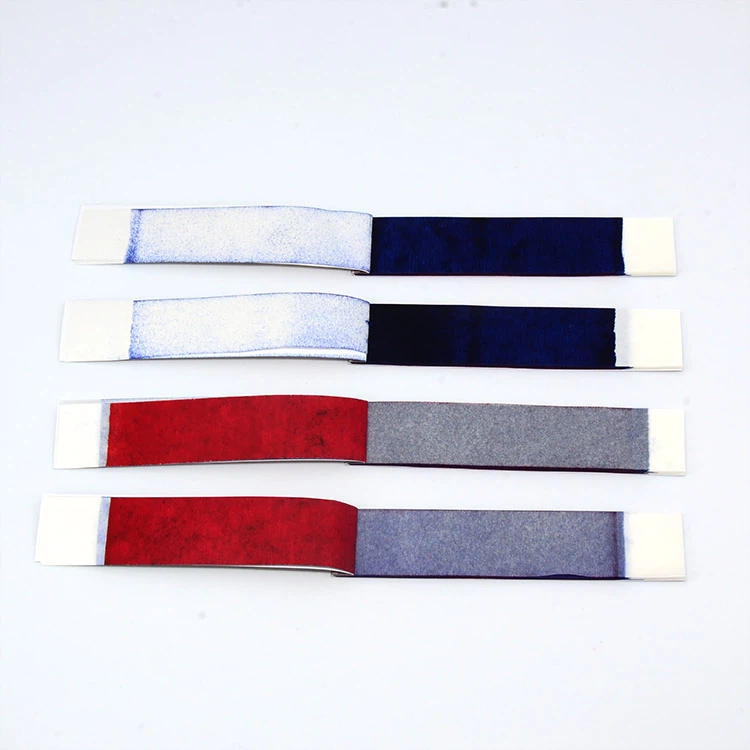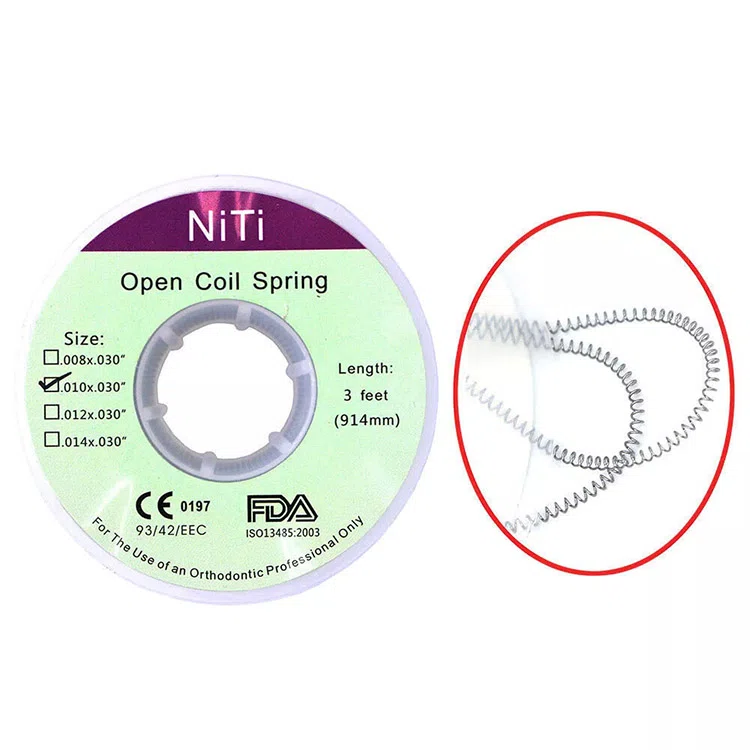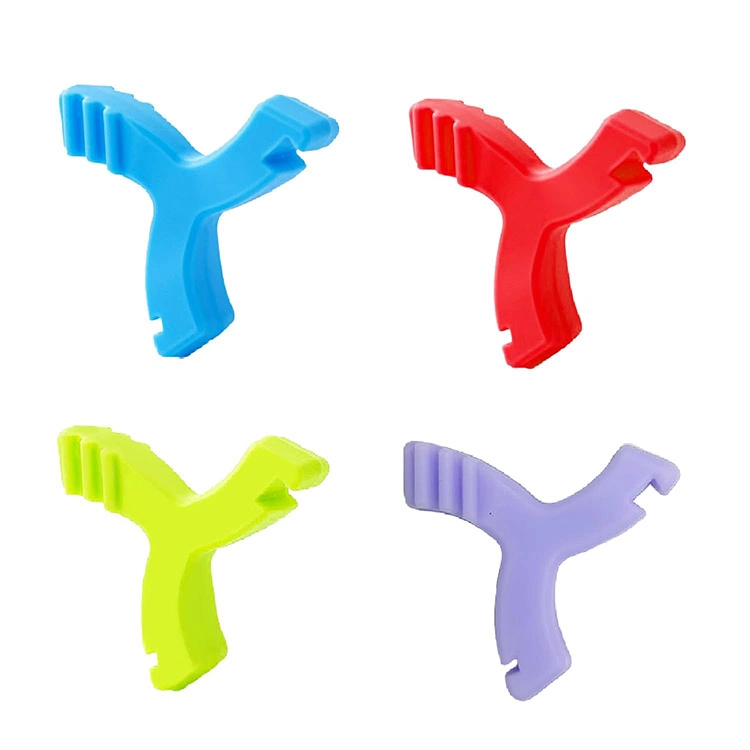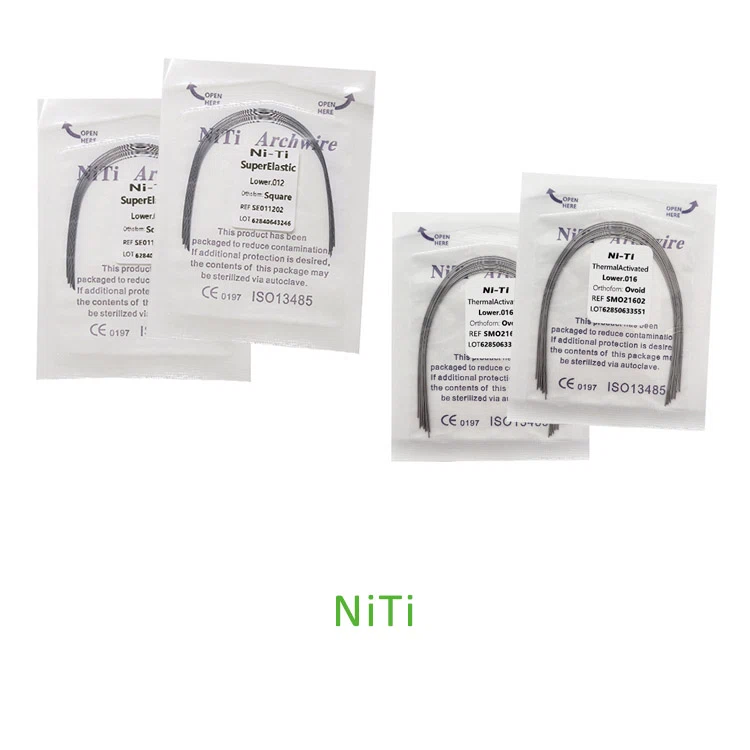
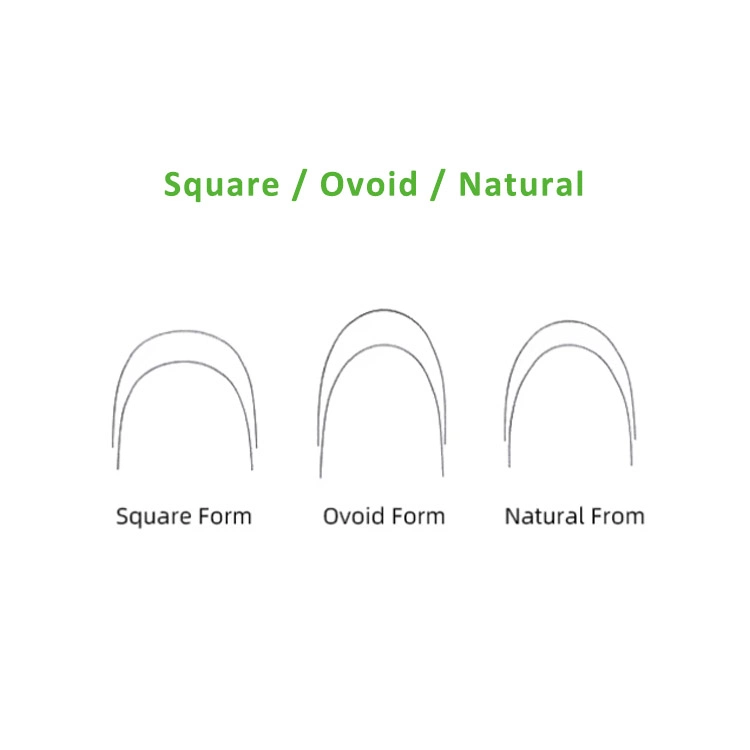
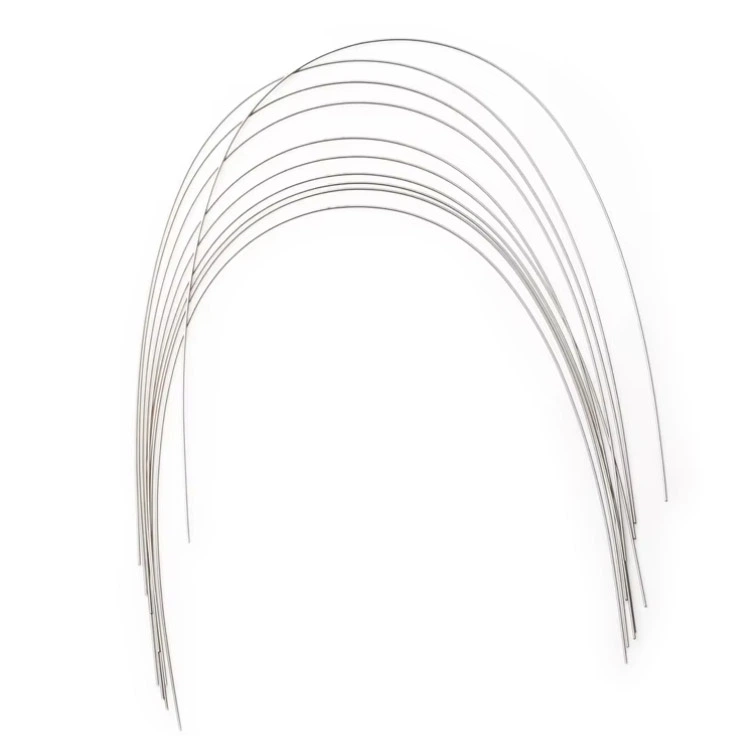
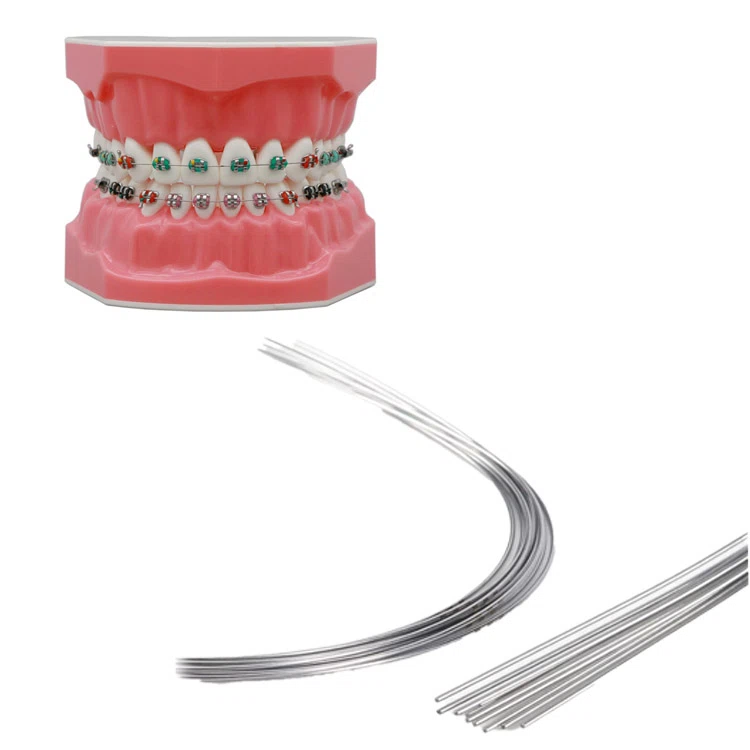
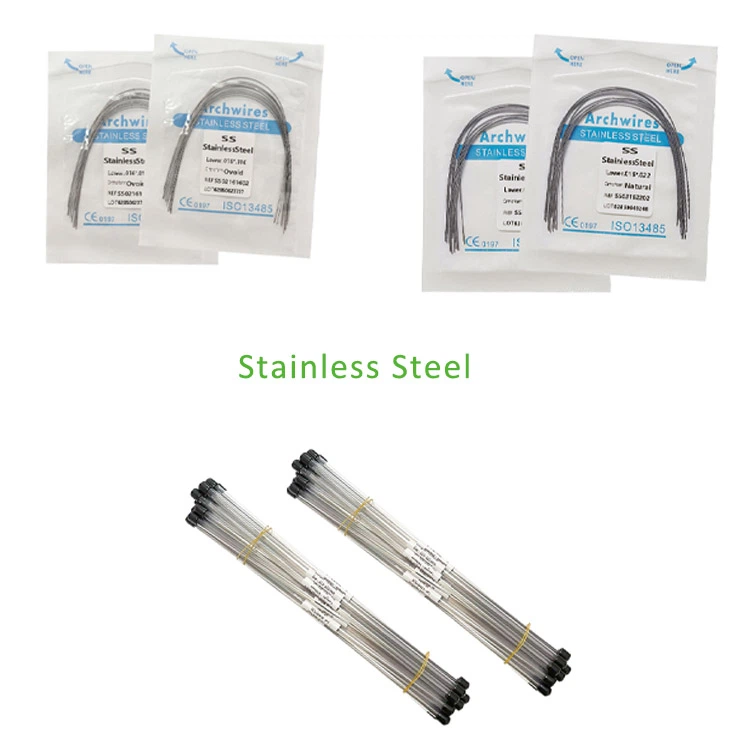
Fio de arco ortodôntico
- Niti / fio de arco de aço inoxidável
- pacote: 10PCs/pacote
- Exibe excelente primavera de volta
- Desempenho consistente
- Alto polido para atrito reduzido
- Tamanho completo da série e tipo de formulário para escolha
O fio do arco ortodôntico aplica pressão nos dentes para induzi -los a se mover para uma posição designada. Geralmente é usado em conjunto com aparelhos, e ajustando a tensão e a direção do fio ortodôntico, Pode melhorar efetivamente o alinhamento dos dentes e problemas de mordida.
Os fios do arco ortodôntico aplicam uma tensão contínua leve sobre os pontos de apoio e ancoragem nos dentes. Esses dentes se moverão sutilmente, No entanto, gradualmente por um longo período de tempo, Mudar para posições desejadas. O resultado do tratamento ortodôntico é o alinhamento dos dentes, Arcos dentários simétricos, e uma redução na magreza entre os dentes, que muda o contorno facial, tornando -o mais harmonioso e esteticamente agradável. Os fios do arco ortodôntico endireitam os dentes e melhoram a capacidade de mastigar com uma mordida melhor.
Categoria de fio de arco ortodôntico
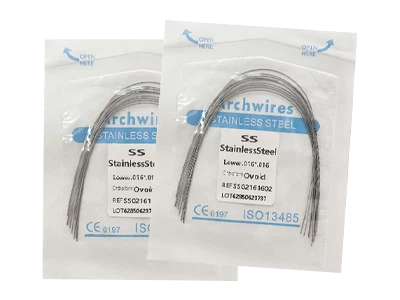
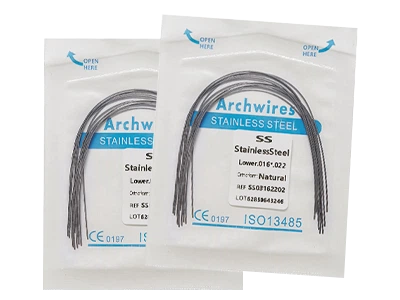
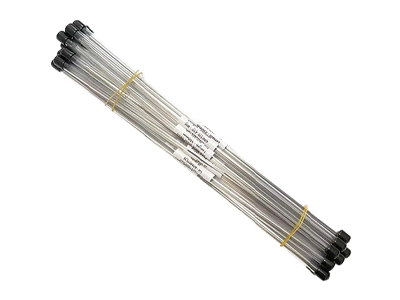
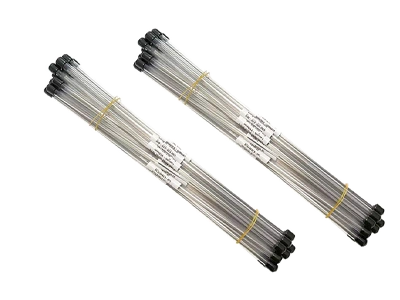
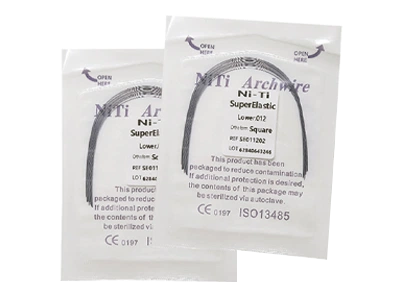
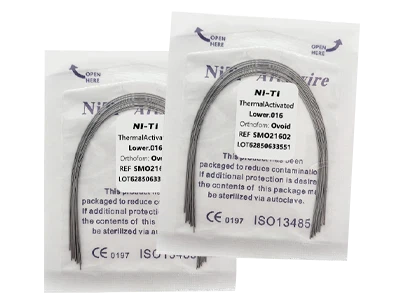
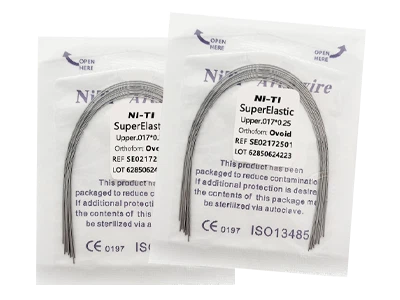
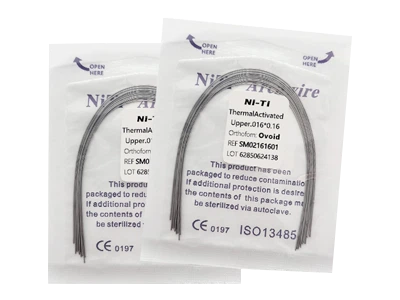
Com base na composição do material, Nossos arco ortodônticos podem ser classificados como fios de aço inoxidável e fios niti. Embora o fio do arco de aço inoxidável seja barato e tenha uma boa resistência à abrasão e corrosão e é estabilidade por muito tempo na cavidade oral, dureza é alta, não tão confortável quanto os fios niti, e baixa em elasticidade. Niti Arch Wire é super elástico e tem uma função de memória de forma. É mais flexível, permitindo que ele se encaixe melhor na superfície do dente, tornando -o mais confortável, mas a um preço mais alto.
Produtos relacionados
A definição dos fios do arco ortodôntico
O arco ortodôntico é um componente chave no tratamento ortodôntico oral. É um material de arame fino com propriedades mecânicas específicas, transmitindo principalmente força ortodôntica através do sistema de braquetes de fio, promovendo o movimento lento dos dentes e ajustando a relação oclusal. Durante todo o processo de tratamento, Os fios ortodônticos desempenham um papel duplo, tanto como “condutor de força” e um “guia de dente”, e seu desempenho afeta diretamente o resultado ortodôntico, duração do tratamento, e conforto do paciente.
Os arcos ortodônticos são normalmente feitos de ligas metálicas, como fios de aço inoxidável compostos de ferro, cromo, e níquel; fios de liga de níquel-titânio feitos de níquel e titânio; e fios de liga de beta-titânio com base de titânio ligado a elementos como molibdênio e nióbio.
Princípio dos Fios do Arco Ortodôntico
O arco ortodôntico transmite com precisão a força ortodôntica predefinida pelo médico ao dente alvo através de sua conexão com os braquetes (bases metálicas ou cerâmicas aderidas à superfície do dente, que são acessórios para tratamento ortodôntico), gerando uma força compressiva e promovendo assim o movimento lento do dente dentro do osso alveolar. O objetivo final é atingir o objetivo terapêutico de endireitar os dentes, coordenando relações oclusais e melhorando a morfologia facial.
Classificação de materiais e características dos fios ortodônticos
1. Fio de aço inoxidável
- Composição: Composto principalmente por metais como ferro, cromo, e níquel (teor de cromo: 17%-19%, teor de níquel: 8%-10%), alguns produtos profissionais também adicionam elementos como molibdênio e titânio para otimizar o desempenho.
- Características: Alta resistência, grande rigidez, forte resistência à corrosão, e menos propenso a ferrugem em um ambiente bucal úmido. Possui módulo de elasticidade moderado, que pode fornecer força ortodôntica estável e tem bom desempenho de processamento. Pode ser dobrado em vários formatos de fio de acordo com os requisitos do tratamento.
- Estágio aplicável: É frequentemente usado nas fases intermediárias e posteriores do tratamento ortodôntico, como ajuste fino após alinhamento dos dentes e correção da relação oclusal, e é particularmente adequado para casos com altas exigências de eficiência ortodôntica.
2. Fio de liga de níquel-titânio
- Composição: Uma liga com memória de forma composta de níquel (50%-55%) e titânio (45%-50%), pode ser classificado em fio de níquel-titânio austenítico e fio de níquel-titânio martensítico de acordo com sua estrutura cristalina.
- Características: Possui efeito memória de forma e super elasticidade, pode retornar à forma predefinida à temperatura corporal, e fornecer continuamente força corretiva suave e estável. Possui baixo módulo de elasticidade, causa menos irritação nos dentes, e melhora o conforto do paciente.
- Estágio aplicável: Usado principalmente na fase inicial do tratamento, como dentes alinhados e oclusão aberta, é particularmente adequado para casos com apinhamento e torção dentária severa, reduzindo efetivamente o desconforto do paciente.
3. Fio de liga de titânio (β -fio de liga de titânio)
- Composição: Ligas formadas pela adição de elementos como o molibdênio, nióbio, e zircônio a titânio como material de base (como liga Ti-Mo-Nb-Zr).
- Características: Combina a alta resistência do fio de aço inoxidável com a boa elasticidade do fio de liga de níquel-titânio, e seu módulo de elasticidade está entre os dois. Possui boa biocompatibilidade e não contém níquel, tornando-o adequado para pacientes alérgicos ao níquel. Possui forte resistência à corrosão e bom desempenho de processamento, e pode ser feito em formas complexas de arame de arco.
- Estágio aplicável: É adequado para a fase intermediária do tratamento ortodôntico, especialmente durante o período de transição dos dentes alinhados para o ajuste fino. Pode não apenas fornecer força corretiva suficiente, mas também garantir a estabilidade do movimento dentário.
Os tipos de forças corretivas dos fios do arco ortodôntico
De acordo com a natureza da força gerada pelos fios ortodônticos, eles são classificados principalmente nos seguintes tipos:
- Força elástica: Quando os arcos ortodônticos sofrem deformação elástica, força elástica é gerada, que é a principal fonte de energia para a movimentação dentária. O fio de liga de níquel-titânio tem o mais suave, força elástica mais estável e duradoura, enquanto o fio de aço inoxidável tem uma força elástica mais forte, mas uma duração relativamente mais curta.
- Atrito: O atrito entre os fios ortodônticos e os braquetes tem um impacto significativo na velocidade da movimentação dentária. Durante a fase de alinhamento dos dentes, é necessário minimizar o atrito tanto quanto possível para aumentar a eficiência do movimento. Durante a fase de ajuste fino, a fricção apropriada ajuda a manter a posição estável dos dentes.
- Força de torque: A força de torque gerada pela flexão do arco ortodôntico pode controlar a inclinação dos lábios e da língua dos dentes, melhorando a relação oclusal e o formato facial. O fio de liga de titânio tem boa estabilidade de força de torque e é um material de controle de torque comumente usado na prática clínica.
Fatores que afetam a força ortodôntica dos fios do arco ortodôntico
- Propriedades dos materiais: O módulo elástico, a resistência ao escoamento e o limite elástico de diferentes materiais variam, que determinam diretamente a magnitude e a duração da força corretiva. Por exemplo, fio de liga de níquel-titânio tem baixo módulo de elasticidade, resultando em uma força corretiva relativamente pequena, mas uma duração mais longa. O fio de aço inoxidável tem um alto módulo de elasticidade, fornecendo uma força corretiva relativamente grande, mas uma duração curta.
- O diâmetro dos fios ortodônticos: O diâmetro dos fios é um fator chave que afeta a força ortodôntica. Quanto maior o diâmetro, quanto maior a resistência e maior a força corretiva. Quanto menor o diâmetro, melhor será a elasticidade e menor será a força corretiva. As especificações de diâmetro comumente usadas incluem 0.012 polegadas, 0.014 polegadas, 0.016 polegadas, 0.018 polegadas, 0.020 polegadas, etc..
- A forma do fio do arco: A forma do fio do arco (como circular, quadrado, ou retangular) afeta a área de contato com o suporte e a força de atrito, influenciando assim a transmissão da força ortodôntica. O fio circular tem uma pequena área de contato e baixo atrito, tornando-o adequado para a fase de alinhamento dentário. Fios quadrados e retangulares possuem uma grande área de contato, que podem transmitir força de torque de forma mais eficaz e são adequados para o estágio de ajuste fino.
Precauções para fios de arco ortodôntico
- Mantenha a higiene bucal: Após o fio ortodôntico ser conectado aos braquetes, restos de comida tendem a se acumular. Se não for limpo a tempo, pode levar ao acúmulo de placa dentária, que por sua vez pode causar problemas como cárie dentária e gengivite.
- Evite mastigar objetos duros: A força e a resistência ao desgaste dos fios ortodônticos são limitadas. Mastigar objetos duros (como nozes, ossos, doces duros, cubos de gelo, etc.) pode fazer com que os fios quebrem, deformar ou os suportes cair, afetando o progresso do tratamento.
- Visitas regulares de acompanhamento: Os pacientes precisam ter consultas de acompanhamento regulares conforme exigido pelo médico (geralmente todo 4 para 8 semanas), para que o médico possa ajustar o diâmetro, formato ou tensão do arco ortodôntico de acordo com a movimentação dos dentes.
- Preste atenção aos sintomas de desconforto bucal: Depois de usar arcos ortodônticos pela primeira vez ou fazer ajustes, os pacientes podem sentir desconforto, como dor de dente ou desgaste da mucosa oral, que geralmente desaparece gradualmente dentro 1 para 2 semanas. Se o desconforto persistir ou piorar, atenção médica deve ser procurada imediatamente para exame.
Perguntas frequentes
Não existe um padrão fixo para a frequência de substituição do arco ortodôntico. Depende principalmente do ciclo de tratamento, a velocidade do movimento dentário e os objetivos da fase de tratamento. Geralmente, durante todo o tratamento ortodôntico (1.5 para 3 anos), fios ortodônticos são substituídos 4 para 8 vezes.
Guarde a parte quebrada e entre em contato com seu dentista. Ele reajustará ou substituirá o arco ortodôntico. Não manuseie sozinho para evitar o risco de ingestão acidental.
Limpe suavemente a área ao redor do arco e dos braquetes com uma escova interdental, e use um fio dental com água para remover restos de comida.
Sim. Após a conclusão do tratamento ortodôntico, o dentista removerá todos os fios do arco ortodôntico, braquetes e outros componentes da boca na última consulta de acompanhamento. Após a remoção, ele limpará e polirá a superfície dos dentes. Recomenda-se o uso de contenções para manter a posição estável dos dentes e evitar que eles se recuperem.
Os princípios básicos de seleção (biocompatibilidade e objetivos de tratamento correspondentes) são consistentes, mas devido às diferentes condições dentárias e periodontais de crianças e adultos, existem diferenças detalhadas.

